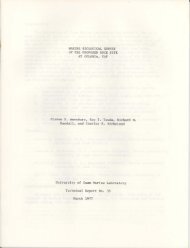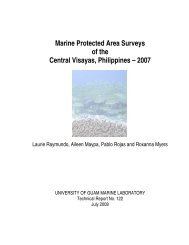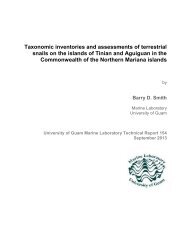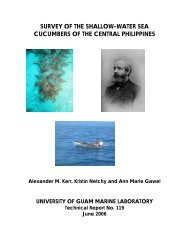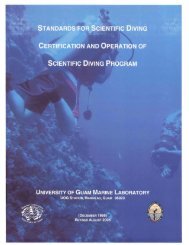Growth of the rabbitfish Siganus randalli Woodland - University of ...
Growth of the rabbitfish Siganus randalli Woodland - University of ...
Growth of the rabbitfish Siganus randalli Woodland - University of ...
- No tags were found...
Create successful ePaper yourself
Turn your PDF publications into a flip-book with our unique Google optimized e-Paper software.
DISCUSSIONComparison <strong>of</strong> dietsBetter growth <strong>of</strong> juvenile <strong>Siganus</strong> <strong>randalli</strong> was obtained with <strong>the</strong> salmon starter thanwith <strong>the</strong> catfish feed. This may be related to <strong>the</strong> higher protein content <strong>of</strong> <strong>the</strong> salmon starter.Parazo (1990) found increased growth <strong>of</strong> juvenile S. guttatus with increasing protein content<strong>of</strong> <strong>the</strong> diet. However, our tests were not designed to test <strong>the</strong> effects <strong>of</strong> specific components<strong>of</strong> <strong>the</strong> diet, and our results suggest that additional work in <strong>the</strong> evaluation and development <strong>of</strong>diets for siganid culture would be useful.The rates <strong>of</strong> growth and feed conversion ratios that we found for S. <strong>randalli</strong> aresimilar to those reported for o<strong>the</strong>r siganids. Parazo (1990) examined <strong>the</strong> growth <strong>of</strong> juvenile<strong>Siganus</strong> guttatus fed 6 semi-purified diets. In that study, apparent feed conversion ratiosranged from 1.54 to 2.03, with specific growth rates ranging from 3.33 to3.77%/day. Also, growth rate (3.85%/day) was higher with <strong>the</strong> commercial reference dietthan with any <strong>of</strong> <strong>the</strong> experimental diets; apparent food conversion efficiency <strong>of</strong> fish fed with<strong>the</strong> commercial diet was 1.60. Less efficient conversion <strong>of</strong> pelletized feeds has been reportedfor siganids in cage culture. For example, Kungvankij et al. (1990) found that apparent foodconversion ratios <strong>of</strong> S. canaliculatus fed ad libitum ranged from 3.4 to 10.7 in a I20-daygrow-out period in cage culture in Indonesia. It is possible that feed conversion efficienciesin <strong>the</strong>se cage-culture trials were low because <strong>of</strong> losses <strong>of</strong> feed through <strong>the</strong> mesh <strong>of</strong> <strong>the</strong> cages.The apparent food conversion ratios <strong>of</strong> juvenile siganids fed at <strong>the</strong> lower ration levelcompared well with those reported for o<strong>the</strong>r fish under commercial cultivation in <strong>the</strong> tropics.For example, juvenile til apia (Oreochromis mossambicus) raised in marine cages in <strong>the</strong>Bahamas were found to have feed conversion ratios <strong>of</strong> 1.2 to 1.3 (Watanabe et aI., 1990).Also, food conversion ratios <strong>of</strong> juvenile Asian catfish (Pangasius sutchi) cultured in Thailandwere reported to range from 1.3 to 2.3 (Chuapoehuk and Pothisoong, 1985). Commercialproducers <strong>of</strong> milkfish (Chanos chanos) on Guam find feed conversion ratios <strong>of</strong> approximately2.0; but in Taiwan, commercial milkfish producers achieve a feed conversion ratio <strong>of</strong> 1.3(Liao and Chen, 1986).Our results indicate that in <strong>the</strong> development <strong>of</strong> feeding regimes for juvenile siganids,<strong>the</strong>re is a trade-<strong>of</strong>f between growth and food conversion efficiency. We found that for 3- to6-g fish , feeding rates greater than 12% will be required to maximize <strong>the</strong> growth <strong>of</strong> juvenilesiganids. However, feeding rates below 12% will be needed to minimize food conversionratios. These factors will be important in evaluating <strong>the</strong> economics <strong>of</strong> holding juvenilesiganids in nursery ponds or tanks prior to <strong>the</strong>ir use in stocking grow-out facilities, as well asin pond culture.20





